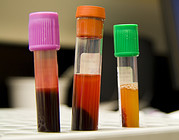Elevated
Inflammation Biomarkers Linked to Increased Mortality in People
with HIV
By
Liz Highleyman
 Inflammation
has become a growing focus of HIV research in the years since the
SMART
study showed that people who interrupted antiretroviral therapy
(ART) were more likely than those on continuous treatment to develop
non-AIDS conditions including cardiovascular, kidney, and liver
disease, and that these conditions were linked to elevated
levels of biomarkers of inflammation, coagulation (blood clotting),
and endothelial (blood vessel) dysfunction. Inflammation
has become a growing focus of HIV research in the years since the
SMART
study showed that people who interrupted antiretroviral therapy
(ART) were more likely than those on continuous treatment to develop
non-AIDS conditions including cardiovascular, kidney, and liver
disease, and that these conditions were linked to elevated
levels of biomarkers of inflammation, coagulation (blood clotting),
and endothelial (blood vessel) dysfunction.
In the present analysis, Phyllis Tien from the University of California
at San Francisco and colleagues with the Fat Redistribution and
Metabolic Change in HIV Infection (FRAM) study looked at the correlation
between 5-year mortality risk and levels of C-reactive protein (CRP;
a biomarker of inflammation) and fibrinogen (a coagulation by-product).
The investigators evaluated data from 922 HIV
positive participants in FRAM, which focused on body composition
changes associated with HIV infection and ART; most participants
were on combination
therapy.
Participants were stratified according to baseline fibrinogen level
(< 319 mg/dL, 319-406 mg/dL, or < 406 mg/dL) and CD4 cell
count. About one-third had either elevated fibrinogen or elevated
CRP; higher levels were correlated with higher viral load and lower
CD4 counts overall, but even some people with well-preserved CD4
counts had elevated biomarkers.
People with the highest fibrinogen levels were on average older,
more likely to be black, and were more likely to have cardiovascular
risk factors including higher total cholesterol, low HDL "good"
cholesterol, more use of medication for high blood pressure, and
higher CRP.
Results
 |
Looking
at fibrinogen alone, the 5-year risk of death for participants
with levels in the highest third (> 406 mg/dL) was 24.7%,
compared with 7.4% for those with levels in the lowest third
(< 319 mg/dL) |
 |
Looking at CRP alone, the 5-year mortality risk for participants
with high levels (> 3 mg/L) was 19.3%, compared with 7.3%
for those with low levels (< 1 mg/L). |
 |
After
adjusting for cardiovascular risk and HIV-related factors,
people with the lowest fibrinogen levels had a 3.4-fold higher
risk of death than those with the lowest levels. |
 |
Similarly,
people with the highest CRP levels had a 3.7-fold higher risk
of death than those with the lowest levels. |
 |
In a multivariate model considering the 2 biomarkers together,
participants with fibrinogen levels in the highest third had
a 2.6-fold higher risk of death over 5 years than those in
the lowest third. |
 |
People
with high CRP levels had a 2.7-fold higher risk of death than
those with low CRP. |
 |
Fibrinogen
remained independently associated with increased mortality
at all CD4 cell levels: |
| |
 |
<
200 cells/mm3: odds ratio (OR) 1.93 per 100 mg/dL increase; |
 |
200-350
cells/mm3: OR 1.43; |
 |
350
to 500 cells/mm3: OR 1.43; |
 |
>
500 cells/mm3: OR 1.30. |
|
 |
Higher
CRP also remained associated with higher risk of death at
each CD4 count level. |
These findings led the researchers to conclude, "Fibrinogen
and CRP are strong and independent predictors of mortality in HIV-infected
adults."
"As expected, we found that the OR for mortality associated
with fibrinogen and CRP was greatest in magnitude for those with
CD4 < 200," they continued in their discussion. "However,
more important is our finding that higher fibrinogen and CRP levels
remained associated with increased mortality risk in participants
with CD4 > 500."
"Our findings suggest that even in those with relatively preserved
CD4 counts > 500 [cells/mm3], inflammation remains an important
risk factor for mortality," they wrote. "These findings
could suggest that the CD4 cells remain immunologically activated
despite CD4 cell restoration. The subsequent persistent inflammatory
state could contribute to non-HIV-related comorbidities such as
liver and cardiovascular disease, which have been reported as the
leading causes of non-HIV-related death in the HAART era."
These results add to the growing body of evidence that starting
ART even earlier than the current
U.S. antiretroviral treatment guidelines threshold of 500 cells/mm3
might be beneficial for some people.
The authors recommended that, "Further investigation should
determine whether interventions to reduce inflammation might decrease
mortality risk in HIV-infected individuals."
Investigator affiliations: Department of Medicine, University
of California at San Francisco, San Francisco, CA; Department of
Medicine, San Francisco Veterans Affairs Medical Center, San Francisco,
CA; Department of Medicine, Stanford University, Stanford, CA; Department
of Medicine, University of California at San Diego, San Diego, CA;
Department of Pathology and Biochemistry, University of Vermont,
Colchester, VT; Department of Epidemiology and Biostatistics, University
of California, San Francisco, CA.
7/13/10
Reference
PC
Tien, AI Choi, AR Zolopa, and others (FRAM study team). Inflammation
and Mortality in HIV-Infected Adults: Analysis of the FRAM Study
Cohort. Journal of Acquired Immune Deficiency Syndromes (Abstract).
June 25, 2010 (Epub ahead of print)
|
|
|
|
 |
|
Stories
of Success in HIV: Proven Interventions for Improving
wareness, Testing, Access to Care, and Treatment of HIV in
Communities of Color.
|
|
|
|
 |
|
Stories
of Success in HIV: Proven
Interventions for Improving wareness, Testing, Access to Care,
and Treatment of HIV in Communities of Color.
|
|
|
